Breaking news! Instagram is launching a “branded content marketplace” — aka, its very own influencer marketplace.
It’s a smart move, since Instagram is a major player when it comes to influencer marketing. 87% of its users say influencers have inspired them to make a purchase, and 70% of shopping enthusiasts turn to Instagram to discover their next purchase.
Brands report Instagram influencer marketing ROI is over 5X: $5.20 for every $1 spent on influencer marketing on Instagram.
Likewise, influencers can expect increasing return on their services; Zuckerberg’s goal is for Instagram’s new marketplace to create a “creator middle class,” where small creators can monetize faster!
So, whether you’re a brand looking to expand your reach or an influencer looking to snag some great sponsorships, this development is great news.
The upcoming Instagram influencer marketplace is still in the works, but brands and creators can still launch great brand-partner relationships today!
While we’re keeping an eye out to see where this mega-successful platform goes next, here are 15 ways to launch a profitable brand-partner relationship…for influencers and brands alike.
We’ve broken establishing a profitable influencer partnership down into overarching steps:
- What is an influencer marketplace?
- Step 1: Set a foundation
- Step 2: Narrow down your partnership search
- Step 3: Check each other out
- Step 4: Research everything you can
- Step 5: Jumpstart your search with these 3 top marketplaces
- Final considerations: Should you use an influencer marketplace?
Click to jump to the most relevant section, or scroll down to get started.
GET NEW INSTAGRAM TOOLS FROM Customers.ai
Grow your Instagram followers and audience with new tools for influencers, artists, brands and D2C businesses. Sign up to be the first to use tools that generate elite engagement via Instagram DMs.
Get InstaChamp Free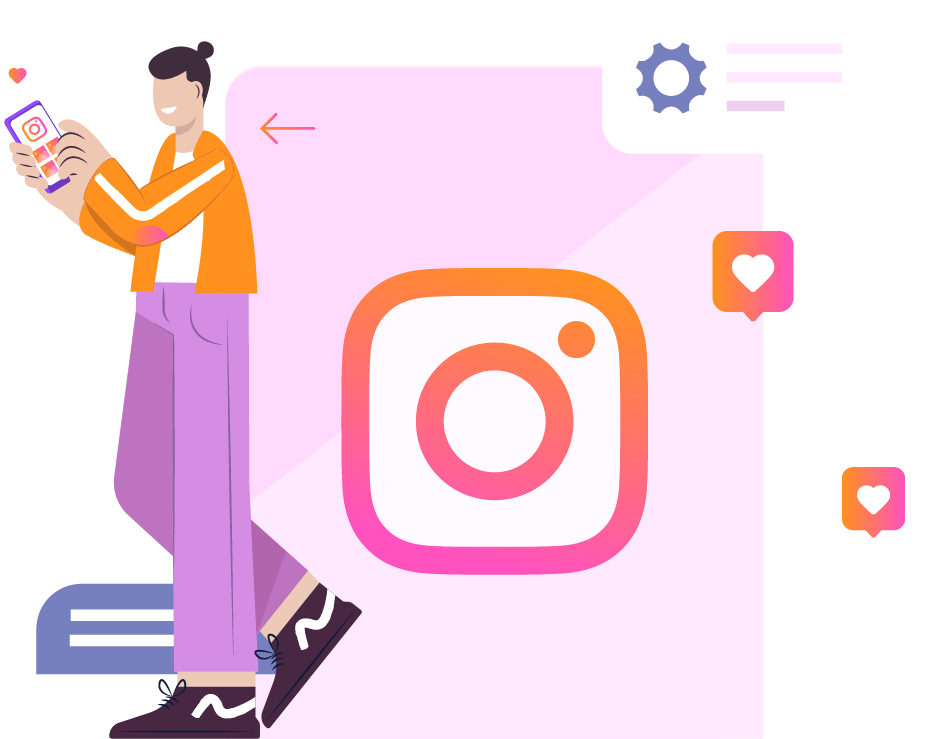
What is an influencer marketplace?
Influencer marketplaces are online filtering tools that help brands and influencers connect with each other.
That’s because there are millions of influencers out there, and screening them one by one would take…well, forever. No one has that sort of time.
And for you influencers, influencer marketplaces are a simple way to connect with brands who are already looking for someone just like you.
You don’t have to hope a brand wants to sponsor you…every brand on the platform is looking for a great-fit influencer, and if you play your cards right, that could very well be you.
So, what’s the best way to take advantage of these platforms?
Well, it all starts with your positioning.
Influencer Marketplace Success Step 1: Set a foundation
1. Write down your goals
Knowing your goals is the #1 step you should take before you make any important decisions.
For brands: What do you want to accomplish with your influencer marketing strategy? How big of a following do you want your influencers to have? How soon do you want to lock down this partnership, and how long do you want it to last?
When working with influencers, it’s super important to ask them to share post insights with you. That’s because you want to be able to track how much web traffic your partner can drive, as well as how many sales they’re making for you.
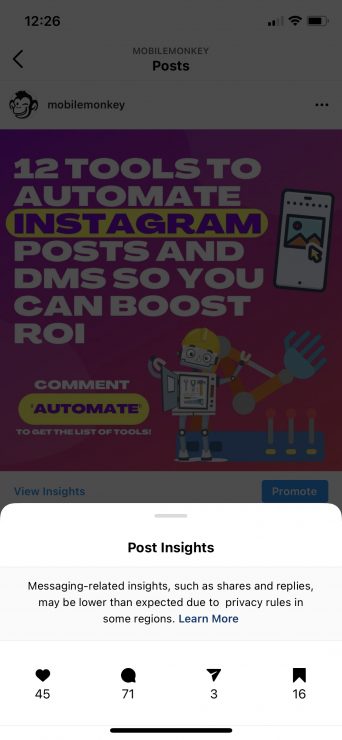
A simple way to do this is to give your partner a specific promo code. Then, track the sales that this promo code brings in. If your influencer is the only person using this code, you’ll know right away how effective their campaign is.
You can also use a UTM tracking parameter on a website URL that attributes website traffic to your influencer partner. InstaChamp makes it possible to automatically send URLs in Instagram DMs – it’s game-changing for driving traffic from Instagram to landing pages and offers.
For influencers: What are you looking for in a brand deal? Do you want to seek out enough brand deals to support you full time? If so, what does that look like? How much money would you need to make from each deal to make a full-time income?
Influencer marketplaces can and do filter out people based on your needs…but in order to find the perfect match, you have to know what you want.
Then, you can use the software available to find it fast.
2. Figure out your budget
For brands, knowing your budget will help you figure out exactly what type of influencer you’re looking for.
Naturally, brands influencers with a larger audience will charge more to promote your product or service. If you’re looking to maximize your brand exposure, outline your budget so you don’t go overboard.
And keep in mind that bigger isn’t always better. Mega-popular influencers can’t always connect deeply with their huge fanbase, while smaller influencers have the advantage of curating a tight-knit community.
#paid, a popular influencer marketplace, provides the following suggested rate sheet for Instagram influencers based on follower count:
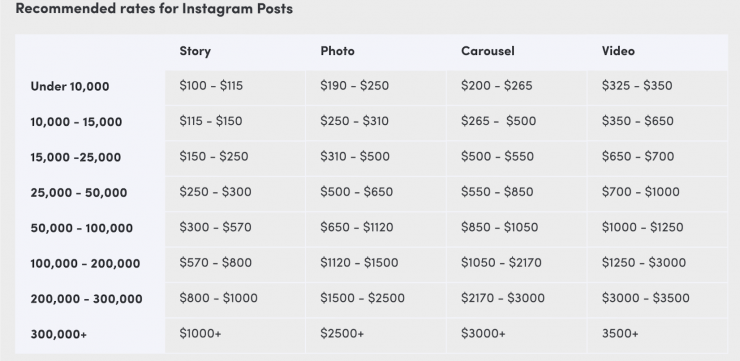
Remember that fans may trust a smaller influencer more than a super popular one. It’s the difference between a friend recommending you a product, and seeing that same product on TV.
You’ll also want to take into account the price of the influencer platform you choose. For influencers, platforms may be free to join, but they may take a cut of your earnings. Check the terms of service and compare platform fees, usage rights, and features.
Meanwhile, for creators: influencer marketplaces can range from cheap to pricey — but remember that you get what you pay for. That’s because more expensive platforms often come with live assistance and expert help, while cheaper options may require you to work on your own.
And for both brands and influencers — if you want to make more sales or set higher rates, check out Customers.ai’s Instagram engagement tools to help you grow your audience!
Our platform can automate your approach to comments and direct messages. That way, you can save time, increase your ROI, and grow your following all at once.
3. Define your niche
As always, the riches are in the niches.
You’ll save hours in your brand-partnership search if you take the time upfront to decide what niche you want to target.
As a brand, you likely already have an established niche for your products and services.
If you’re an up and coming influencer, you’ll want to make extra sure that you’re marketing yourself the way you want to be seen. Are you a fashion influencer? A lifestyle blogger? A tech guru?
This step is crucial, because leaning hard into one niche will make it easier for brands to find you…and vice versa.
Influencer Marketplace Success Step 2: Narrow down your search
4. Know your influencer tier
In general, influencers are sorted into four tiers.
Nano: 10,000 followers or less
Micro: 10,000 – 100,000 followers
Macro: 100,000 – 1 million followers
Mega: 1 million+ followers
For influencers, knowing what tier you’re at will help you figure out how brands perceive you. It’ll also help you negotiate sponsorship deals.
Even if you’re still a micro or even a nano-influencer, you can still provide real value to brands by genuinely recommending their products to your community.
Hubspot reports that engagement on a piece of content peaks at around 1,000 followers, which means that even very small influencers can have a positive impact on a brand’s ROI.
For brands: All of the above applies to you, too. By establishing your budget and determining your goals, you can use influencer marketplaces to search only for influencers with the reach that you want.
5. Search for experts in your field
This is especially important for brands that offer technical products and services.
If you’re able to connect with an influencer who’s an expert in your field, it will be a lot easier for them to explain your products or services to your audience.
They’re also a lot more likely to get hype about it, which is always a good thing.
For example, a lifestyle blogger might not really understand how impressive the specs are on a tech brand’s newest gaming laptop. Meanwhile, a YouTube gamer might not really see the appeal in all-in-one tanning lotion sunscreen.
You get the idea. Search for like-minded creators, and you’ll see much better results with your product placements.
6. Find the best social media platform to showcase your product
This one might seem like a no-brainer, but it’s important!
Not all social media platforms are created equal, and influencers will have different effects across different social media accounts.
A YouTuber with over 1 million subscribers isn’t the same as an Instagram influencer with 1 million+ followers. And, it’s important to think about what social media channels will showcase your product or service the best.
If you’re selling physical products, for example, Instagram could be a great place to show them off. But, if you’re selling a less-visible service, it might be easier for an influencer to explain what you’re offering via YouTube.
Also, remember to research where your target audience hangs out. You probably don’t want to target TikTok if your main customer base is over sixty.
Influencer Marketplace Success Step 3: Check each other out
7. Brands: vet your influencers!
Influencer marketplaces make it way easier to screen out unqualified influencers, but your work doesn’t stop there.
While online tools do make it easier to find out who’s using fake followers, you’ll also want to look at audience demographics, see how they’ve handled brand deals in the past, and — most importantly — confirm that they actually want to work with you!
(People can smell insincerity. You’ll get best results from influencers who actually like your product!)
Tools like Hypeauditor can help you out with this. You can search an influencer’s social media handle, and the site analyzes their following for you.
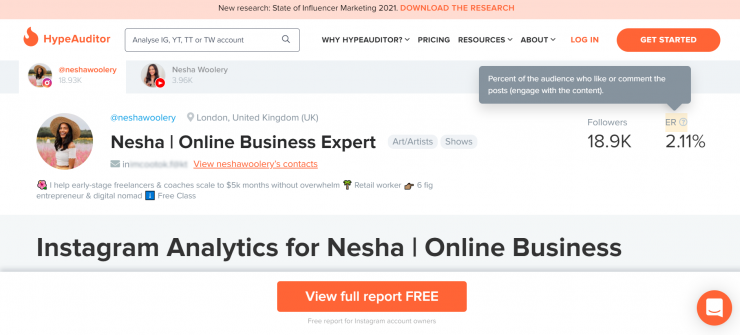
For example, HypeAuditor makes it easy to see an influencer’s follower count, the percent of people who engage with their content, their location, and their contact info. Given that tracking down emails alone can be a daunting task, this tool is a huge time saver.
8. Influencers: vet your brands and platforms!
With brands vetting influencers left and right, it’s only fair that they should also get a turn in the hot seat.
When brands reach out to you, make sure you actually like their product and that your brand values align. Also check that you have similar audiences, so your followers don’t feel like you’re pushing a product on them that they don’t want.
Before you sign anything, make sure you and the brand are on the same page about timelines, rates, and deliverables.
You’ll also want to check how much control the brand wants over the sponsorship — some brands will want you to stick to a script, while others are okay with you doing pretty much anything (as long as it’s positive, of course).
It’s also important to read the fine print in any given influencer marketplace’s Terms and Conditions to decide if you’re okay with their pricing, platform fees, and usage rights policies.
9. Put yourself in each other’s shoes
In an ideal world, brands and influencers would always be perfectly aligned.
Brands would search for the best-fit partner with an audience who will love their product. Influencers would be over the moon to partner with the creators of their favorite brands.
The reality is that most people are self-focused. Brands try to figure out how to get as much exposure as possible, and influencers are trying to snag enough brand deals to make ends meet. Both of your brand ideals, personality, and goals can get lost along the way.
So, whether you’re a brand or an influencer, put yourself in each other’s shoes. Talk to each other to figure out exactly what you each want from this partnership! And don’t assume you know everything about a brand or influencer before you’ve spoken with them in-depth.
Influencer Marketplace Success Step 4: Research everything you can
10. Explore influencer marketplaces
Now that you’ve figured out your goals, budget, audience, and reach, it’s time to look for an influencer marketplace that can connect you with the right people as fast as possible.
Consider the factors that you need the most help with. Is your team expert at vetting influencers, and you just need a complete database? Or do you want expert help to walk you through the partnership process?
Knowing exactly who you want to find is key here. If you already know your target demographic, level of influencer, and budget, look for an influencer marketplace that lets you filter influencers by these factors.
In-depth research is the most important thing you can do before committing to an influencer marketplace. Because of this, the rest of our tips are devoted to exploring research tools and examining a few popular marketplaces to get you started.
11. Analyze influencer marketplace ratings with G2
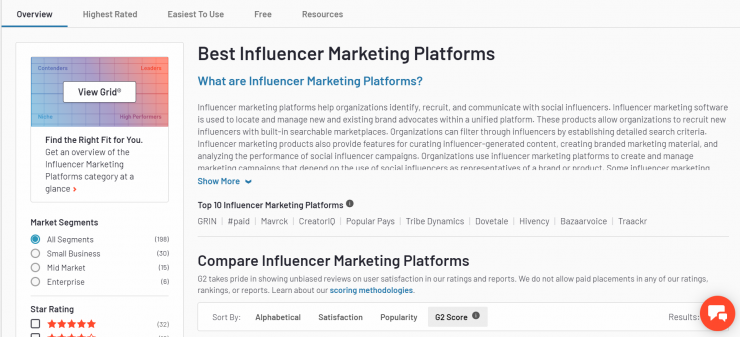
The software review website G2 lets you sort influencer marketing platforms by market segments, star rating, languages supported, and pricing options.
Off the bat, you’ll see marketplace entry level prices and descriptions. Then, when you click on an influencer marketplace review, you’ll see a site overview as well as links to community discussion about the marketplace.
You’ll also see site screenshots, downloads, and customer reviews. And if that weren’t enough, the right sidebar also shows you features, top industries represented, user ratings, and comparisons.
When it comes down to it, if you have a question about an influencer marketplace, G2 likely has the answer. This is a site that belongs on your bookmarks bar.
12. Read in-depth influencer marketplace reviews on Influencer Marketing Hub
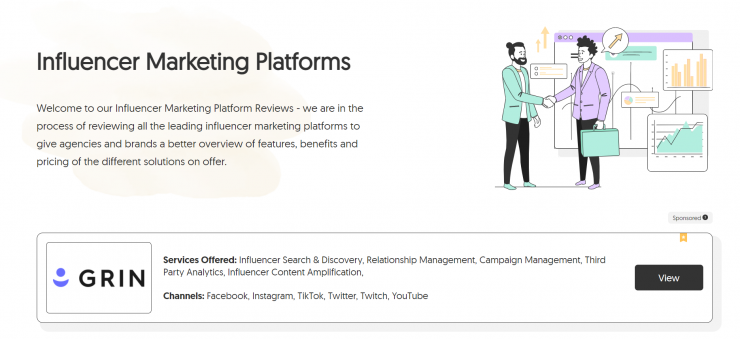
Influencer Marketing Hub calls itself the leading social media resource for brands, and it’s easy to see why.
This platform hosts overviews of the top influencer marketing agencies across a variety of social channels. When you click “View,” you’ll learn what each influencer marketplace does, which platforms it specializes in, and what services it offers.
You can also find out where each marketplace’s physical offices are, which brands it has worked with, and where it’s been featured.
The only thing missing from Influencer Marketing Hub is customer reviews. By using this website together with G2, you can quickly get a comprehensive overview of the top marketplaces out there.
Influencer Marketplace Success Step 5: Jumpstart your search with these 3 marketplaces
Now that you’ve got a solid plan, it’s time to look at a few influencer marketplaces that can get your next brand-partner relationship off the ground.
13. Brybe
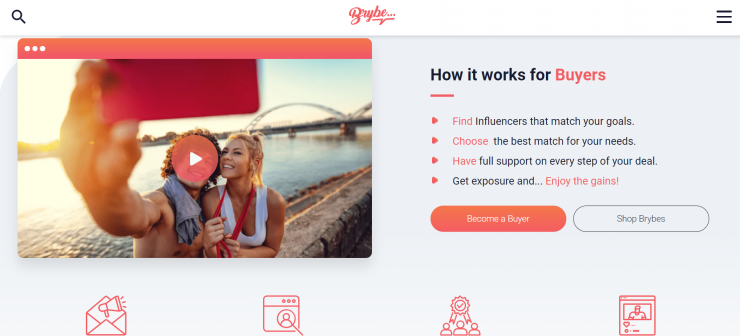
Brybe is one of the only influencer marketplaces to let brands do package deals with influencers.
Influencers can set up these deals, called “brybes,” and offer ready-made services, like this:
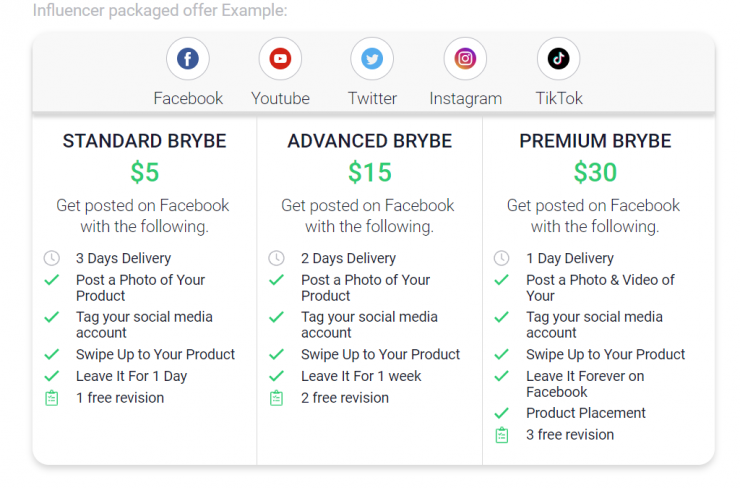
This makes it easy for brands to see what they’re getting. It makes communication as simple as a few clicks.
And influencers aren’t the only ones taking the lead on Brybe. Brands can also post requests for promotions, receive offers from multiple influencers, and select the best deals.
It’s also available in app form for Android (iOS coming soon).
Major brands: TripAdvisor, Jeep, Adobe, Adidas, Samsung
Made for: Lower to mid-level brands, creators, and influencers
Reviews: Brybe is a newer platform, so it doesn’t yet have reviews on G2 and Influencer Marketing Hub. However, reviews from professional blogs and press releases are mostly positive.
“It’s a great way to start a friction-free relationship.”
Neil Schaffer, Marketing Guru
Pros:
- Brybe is one of the few influencer marketplaces to speak directly to influencers as well as brands
- One of the only package-deal influencer marketplaces available
- A smaller platform makes it easier for low to mid-level brands and influencers to find each other
- It’s free to sign up
Cons:
- Since Brybe is a newer platform, it’s hard to find verified reviews
14. Influencity
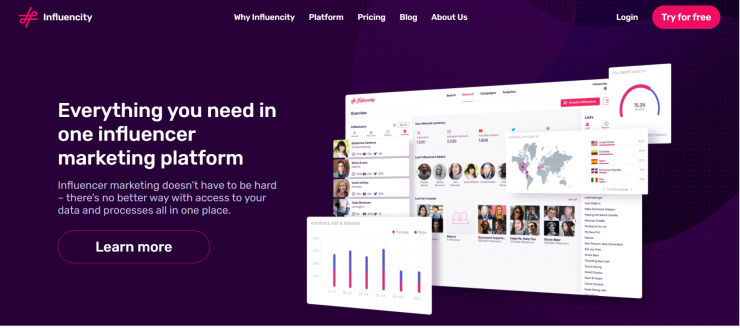
Influencity is one of those marketplaces that you’ll see pop up a lot in marketplace roundups.
That’s because it hosts over 60 features to help brands and influencers connect. With this tool, you can:
- Find influencers
- Analyze influencers
- Organize your search
- Forecast your results
- Manage your marketing campaigns
- Measure your results
Over 70 million influencers use the platform, which means brands can find influencers anywhere in the world. It hosts detailed demographics tools, as well.
Influencity is a paid tool, with plans starting at $48/month. Each of its tiers starts with a 7-day free trial so you can get a feel for the place.
Major brands: Dentsu, Samsung, WPP, Kellogs, OMG
Made for: SMBs and Enterprise
Reviews: Influencity has 57 reviews on G2 and a 4.6 out of 5 star rating.
“This tool generates relevant profiles to help you identify exactly who you should reach. This makes outreach so much easier when you know who to choose.”
Laura Goicoechea, Influence Manager for Isobar
Pros:
- Huge outreach — 70 million influencers available to you
- An extremely wide array of tools
- A track record of success with major brands
- Pricing tiers make it accessible to businesses of multiple different levels
Cons:
- Website doesn’t speak to influencers at all
- It’s hard to find verified reviews of what it looks like to be an influencer found through Influencity
15. #paid
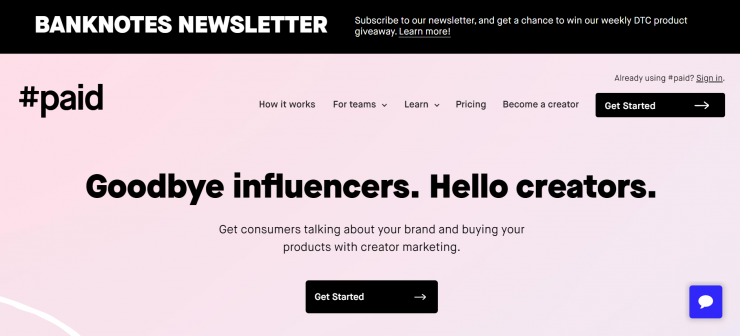
#paid approaches influencer marketing from a new angle: content creation.
This influencer (or shall we say creator?) marketplace aims to be the all-in-one solution to brand partnerships. The site matches your creative brief with ideal creators. Meanwhile, creators are also able to pitch their campaign concepts to you.
This way, #paid turns away from the ideas that influencer marketing is a simple transaction. It’s a creative process, and influencers and brands are in it together.
Because of this, the #paid platform offers tools like:
- A #paid-specific inbox, so you can communicate with creators
- A Support Manager who’s a real person
- Built-in post previews
- Campaign scheduling (and reminders)
#paid also provides campaign insights.
And for creators, #paid promises a culture of authentic collaboration, where you only work with brands you’re actually excited about.
For brands, #paid is one of the pricier tools out there, starting at $269/month (when paid annually). Creators can sign up for free.
Major brands: Uber Eats, Nestle, Visa, Canon, H&M
Made for: SMBs, Agencies, Enterprise, Direct-To-Consumer Brands
Reviews: #paid has 122 reviews on G2 and a 4.7 out of 5 star rating.
“#paid respects my style and actually makes an effort to find campaigns that are a perfect match for me.”
Abhishek D., @abhishekdekate
Pros:
- A huge user base with mostly positive reviews
- Creator reviews and testimonials on #paid’s site and G2 are enthusiastic
- Built-in inbox, post preview, and scheduler makes collaboration easy
- Multiple reviews on G2 call #paid the best platform available
Cons:
- It’s not clear what #paid’s payment processing fees are for creators
- #paid’s high upfront price could make it difficult for small businesses to access (although multiple small businesses have left 5-star reviews on G2)
Should you use an influencer marketplace?
Influencer marketplaces aren’t the only way for brands to get in touch with creators (and vice versa), but they take a lot of the guesswork out of the process.
With these 15 tips at your disposal, you’re now equipped to get into the weeds and kickstart a fantastic brand-partner relationship. Set your foundation, decide on your angle, do your research…and don’t forget to have some fun along the way.
Whether you’re an influencer searching for brand deals, or a business hunting for the perfect partnership, our new Instagram tools can help you grow your audience through Instagram DM automation. Get InstaChamp free or check out the link below.
In the meantime, we’d love to hear from you! What have you found is the hardest (or most time-consuming) part of searching for that perfect-fit brand partnership? Let us know in the comments.
GET NEW INSTAGRAM TOOLS FROM Customers.ai
Grow your Instagram followers and audience with new tools for influencers, artists, brands and D2C businesses. Sign up to be the first to use tools that generate elite engagement via Instagram DMs.
Get InstaChamp Free
